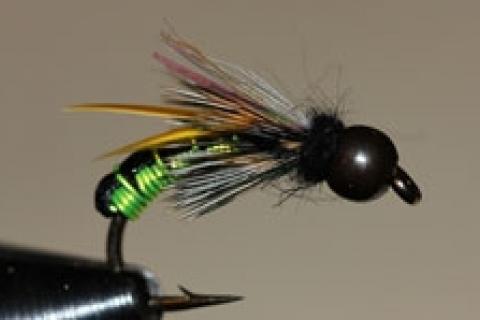
Caddis fly patterns are some of the most productive patterns that fly fisherman can try and imitate. The majority of a trout's respected diet is aquatic invertebrates and one of the most numerous aquatic invertebrates found in rivers and streams is the caddis nymph.
The Wired Caddis pattern best imitates emergent caddis's that are in the process of leaving their shucks to reach the surface. Using a Wired Caddis pattern tied in darker body tones like gold or copper could also pass for several aquatic worms or even small dragon/damselfly nymphs.
The tying materials used in the Wired Caddis are critical to this patterns success with trout. While the sparkle of the wire body and the flashabou get a trout's attention, the weight of the wire and the bead get this fly down to where fish feed. The partridge hackle and dubbed collar give this fly and overall natural look and feel to fish when they are drowned and at eye level with trout.
Carrying several sizes and colors of the Wired Caddis is a good idea. If you are fishing new streams or trying this pattern in varying seasons, you will need to match the aquatic life that is present. In general, flies in the 12-16 range are the most productive during the summer months (July to August), and in early spring (April to May) bigger sized patterns work best (8-10). In addition to this lighter patterns (tans, olives browns) work best during the summer months will darker patterns (blacks, dark brown) work better in spring and fall.
To fish the Wired Caddis it is best to use a 9 foot fly rod (3-5 wt or larger if fishing really big water) and a 9 to 12 foot long light leader. You want to have a long supple leader so the fly can sink and drift naturally along the bottom. If you find that you don't feel the bottom on multiple drift, try adding a bit of lead free eight to the leader to get it drifting deeper. Fish will actively feed on insects that become dislodged from the river bottom so keeping your fly down where the fish are is critical to your success.
A good approach to take when prospecting a new section of river is to pick a fishy looking run or holding structure and place a upstream and across cast to deliver your fly. Keep in mind that when you are delivering your fly it is going to take time for your fly to sink to the bottom. Cast far enough upstream so that the fly can sink to the desired depth by the time you reach your target. Just like dry fly fishing once your fly is in position you will have actively mend the line so you achieve a drag free drift past you target.
Materials List
| Hook | Daiichi Curved Hook Shank, Size 10 |
| Thread | Black Uni-Thread 8/0 |
| Back | Black Raffia |
| Head | Black Brass Bead Head |
| Body | Green Medium Ultra Wire |
| Hackle | Hungarian Partridge Soft Hackle |
| Wing | Amber Goose Biots |
| Collar | Black Rabbit Dubbing |
| Flash | Pear Flashabou |
Step-by-step tying instructions for the Wired Caddis
| Step 1 To start this fly, select an appropriate hook and slide the bead over the hook point small hole first. Place the hook into the vice securely and slide the bead up to the back to the hook eye. | |
| Step 2 Attach the thread to the hook shank behind the bead and cut off the tag end. | |
| Step 3 Cut a small section of black raffia (3 inches) and wrap it down with thread until you reach the point above the barb. | |
| Step 4 Cut a small section of green wire (3 inches) and wrap it down to the bottom of the hook shank until you reach the point above the barb. | |
| Step 5 Make four turns of green wire up the body of the fly then pull the raffia over top of the wire. | |
| Step 6 Take one turn of wire over the raffia then pull the raffia and keep wrapping the wire forward. Create four separate body sections of green wire with the raffia then tie off the wire and raffia and cut the tag ends. | |
| Step 7 Tie down two gold goose biots extending off the back of the fly the length of the wire body. | |
| Step 8 Select a nice Hungarian partridge hackle and tie it down in front of the goose biots. Wrap this hackle around the hook shank making sure not to wrap down any of the hackle fibers. Sweep the hackle fibers towards the rear of the fly and tie off the feather. | |
| Step 9 On the top of the fly tie in 6 flashabou fibers and cut them to about a 1/4 inch in length. | |
| Step 10 Dub the thread with the black rabbit dubbing and create a small collar for the fly. Whip finish and cement the head. |
- 3218 views

